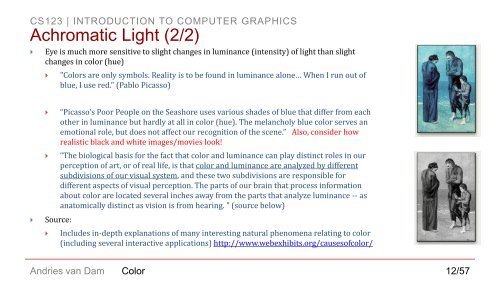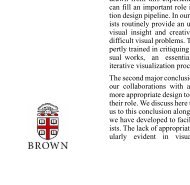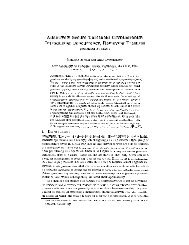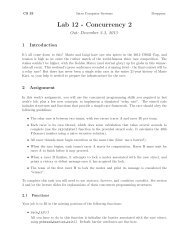Introduction to Color - Brown University
Introduction to Color - Brown University
Introduction to Color - Brown University
You also want an ePaper? Increase the reach of your titles
YUMPU automatically turns print PDFs into web optimized ePapers that Google loves.
CS123 | INTRODUCTION TO COMPUTER GRAPHICS<br />
Achromatic Light (2/2)<br />
<br />
Eye is much more sensitive <strong>to</strong> slight changes in luminance (intensity) of light than slight<br />
changes in color (hue)<br />
<br />
"<strong>Color</strong>s are only symbols. Reality is <strong>to</strong> be found in luminance alone… When I run out of<br />
blue, I use red." (Pablo Picasso)<br />
<br />
<br />
<br />
Source:<br />
<br />
“Picasso's Poor People on the Seashore uses various shades of blue that differ from each<br />
other in luminance but hardly at all in color (hue). The melancholy blue color serves an<br />
emotional role, but does not affect our recognition of the scene.” Also, consider how<br />
realistic black and white images/movies look!<br />
“The biological basis for the fact that color and luminance can play distinct roles in our<br />
perception of art, or of real life, is that color and luminance are analyzed by different<br />
subdivisions of our visual system, and these two subdivisions are responsible for<br />
different aspects of visual perception. The parts of our brain that process information<br />
about color are located several inches away from the parts that analyze luminance -- as<br />
ana<strong>to</strong>mically distinct as vision is from hearing. ” (source below)<br />
Includes in-depth explanations of many interesting natural phenomena relating <strong>to</strong> color<br />
(including several interactive applications) http://www.webexhibits.org/causesofcolor/<br />
Andries van Dam<br />
<strong>Color</strong> 12/57
















